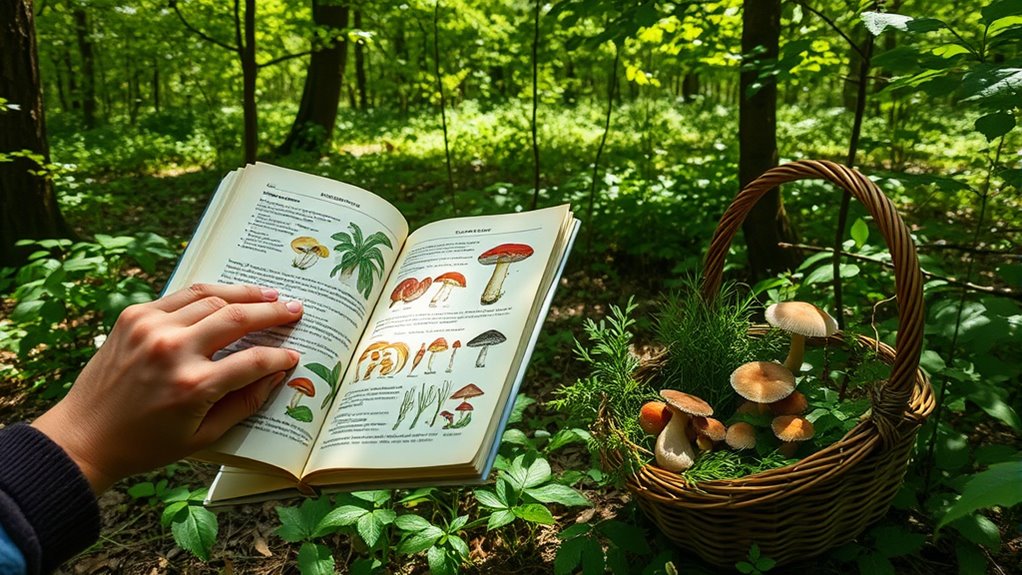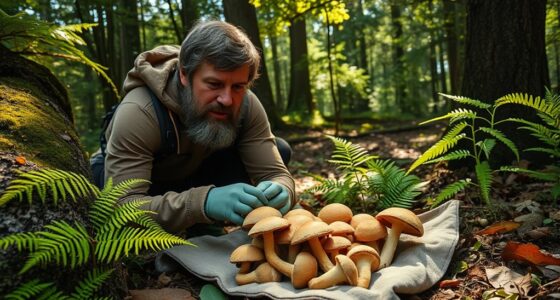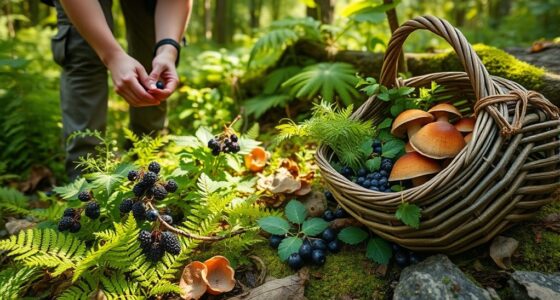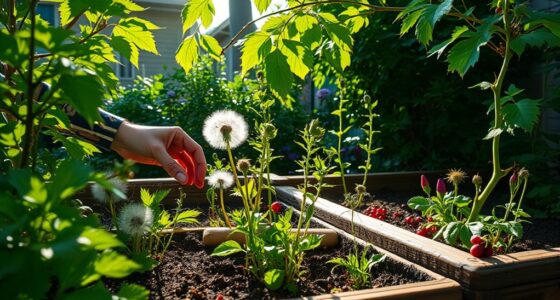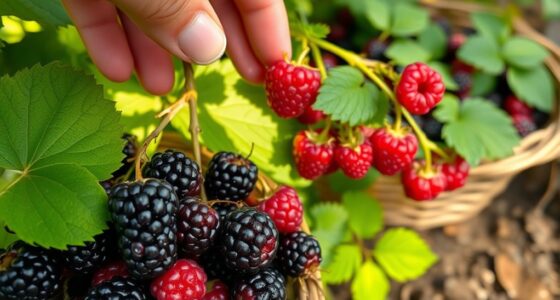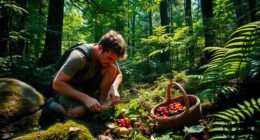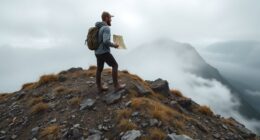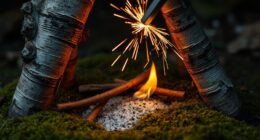To use foraging field guides effectively, familiarize yourself with their features like detailed indexes, illustrations, and symbols indicating edibility or toxicity. Cross-reference multiple guides to improve accuracy and spot regional variations. In the field, observe plant details such as leaf shape, flower structure, and habitat clues, then verify findings with your guides. Practice with sample plants and visual aids, and incorporate guides into your routine for safer, more confident foraging—keep exploring to learn even more.
Key Takeaways
- Cross-reference multiple guides to confirm plant identification and avoid look-alikes.
- Familiarize yourself with symbols and illustrations for quick recognition in the field.
- Observe detailed plant features such as leaf shape, flower structure, and habitat clues.
- Practice matching live plants with photographs or herbarium samples to improve accuracy.
- Review guides before and after foraging to reinforce identification skills and deepen knowledge.
Familiarizing Yourself With Guidebook Features

To use a foraging guidebook effectively, you need to become familiar with its key features. Field guides often include a detailed index and table of contents, helping you quickly locate specific plants or categories. Pay close attention to identification features such as leaf shape, flower structure, and fruit type, which are highlighted in descriptions. Examine the illustrations and photographs carefully to understand the plant’s typical appearance and variations. Symbols and icons indicate edibility, toxicity, habitat preferences, and seasonal availability, guiding safe foraging. It’s also essential to recognize look-alikes and poisonous species, which are usually distinguished by specific features in the guide. Mastering these elements ensures you identify plants accurately and confidently.
Cross-Referencing Multiple Resources

When you compare multiple foraging guides, you gain a clearer and more reliable picture of plant and mushroom identification. Cross-referencing different resources helps improve accuracy by revealing consistent features across sources. Each guide may highlight various growth stages or regional variations, giving you a more complete understanding. This comparison aids in distinguishing look-alikes and reduces misidentification risks, especially when toxins are involved. Using several resources to examine images, descriptions, and habitat details deepens your knowledge and boosts confidence in field identification. Relying on diverse sources also clarifies ambiguous features and exposes you to a broader range of species diversity. Incorporating research-backed content ensures that your foraging efforts are both safe and successful. Additionally, understanding market growth and technological advancements can inform the development of more effective identification tools. Developing comprehensive field skills is essential for safe foraging and accurate identification. Recognizing the importance of climate control innovations can also inspire the integration of environmental considerations into sustainable foraging practices. Ultimately, cross-referencing strengthens your ability to identify safe, edible plants and mushrooms with greater certainty.
Observing and Identifying Plants in the Field

Observing and identifying plants in the field requires careful attention to detail and a systematic approach. During field observation, focus on plant features such as overall shape, size, and growth habit to differentiate species. Use habitat clues like soil type and location to narrow possibilities. Examine diagnostic traits like leaf venation, margins, and stem characteristics, along with visual cues like flowers or fruit structures, for accurate plant identification. Take note of specific habitat preferences that can help confirm your observations. Cross-reference your findings with foraging guides, paying close attention to detailed descriptions and illustrations. Developing wild plant recognition skills depends on observing these features carefully and consistently, which improves your ability to identify plants reliably in various environments. Additionally, understanding the types of electric bikes and their capabilities can enhance your appreciation of alternative transportation options when exploring natural areas.
Practicing With Visual Aids and Sample Plants
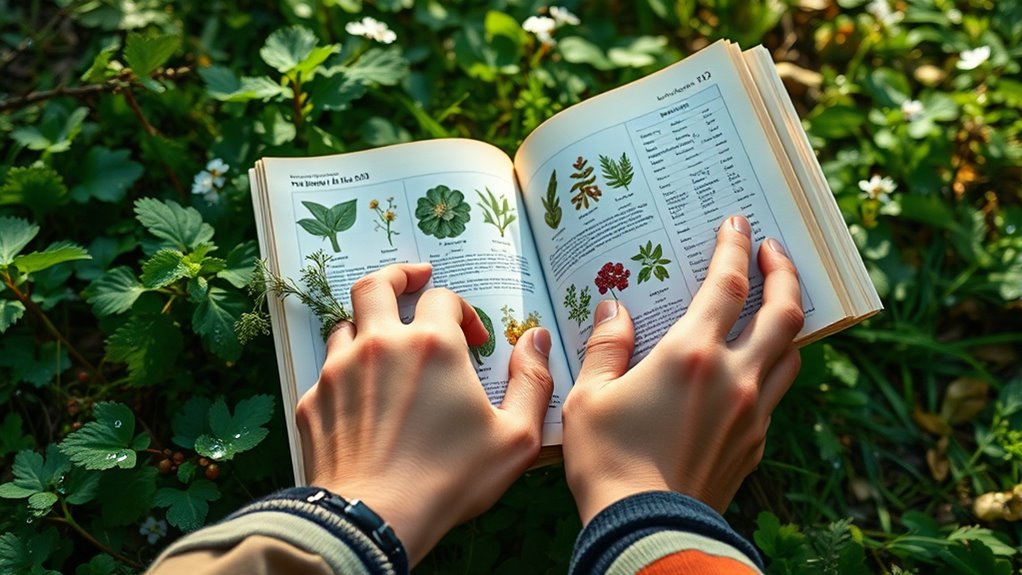
Practicing with visual aids and sample plants is essential for honing your plant identification skills in the field. Using sample plants or herbarium specimens alongside your field guide helps you familiarize yourself with key diagnostic traits like leaf arrangement, flower structure, and stem features. Practice matching photographs in your guide to real-life plants across different growth stages and seasons to strengthen your recognition skills. Creating or gathering small plant samples allows you to observe details up close, enhancing your understanding of plant characteristics. Visual aids such as color swatches or magnifying glasses can help you examine diagnostic traits more precisely. Additionally, exploring diverse plant designs and materials can deepen your appreciation for plant varieties and their unique features. Incorporating materials needed for candle making into your practice can also help you understand different plant-derived waxes and their properties. Studying plant morphology and variations across regions can further improve your identification accuracy. Engaging with local botanical knowledge and traditional uses of plants can enrich your foraging experience and understanding of their significance. Developing a familiarity with cultural narratives associated with certain plants can enrich your foraging experience and understanding of their significance. Consistently comparing your observations with field guide images and descriptions builds your confidence, ensuring more accurate and efficient plant identification during your foraging adventures.
Incorporating Guides Into Your Foraging Routine
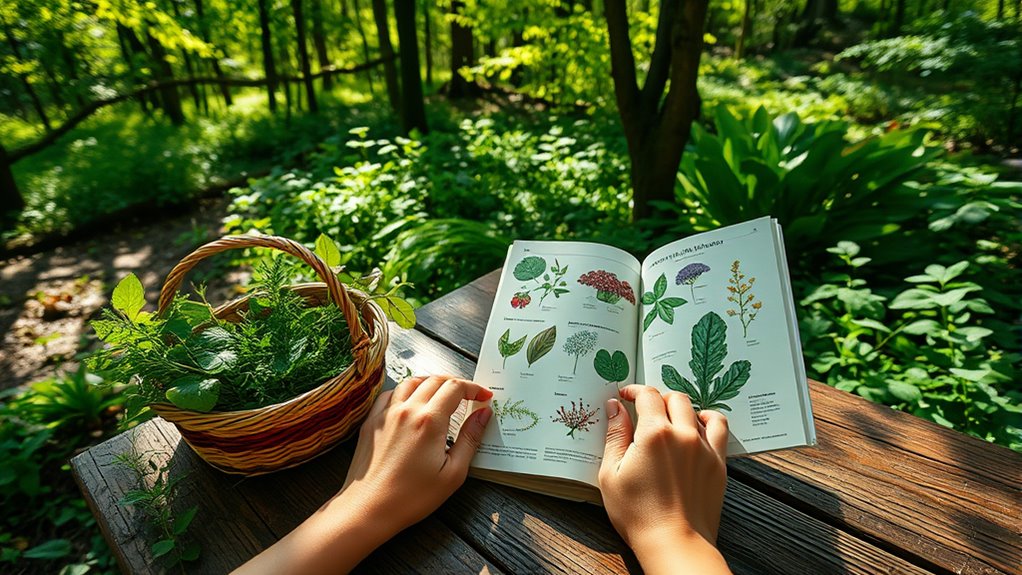
Incorporating guides into your foraging routine guarantees quick and accurate plant identification in the field. To maximize their effectiveness, you should:
- Carry a compact, region-specific field guide with clear photographs and detailed descriptions to aid plant identification, especially for novice foragers.
- Cross-check multiple resources to confirm species, reducing risks from look-alikes and seasonal variations.
- Review your guides before and after each outing, reinforcing identification skills and ensuring plants are safe to eat.
- Be aware of plant identification techniques and potential look-alike species to avoid misidentification and ensure safe foraging. Additionally, understanding the cultural significance of plants can deepen your appreciation and knowledge, especially when learning about the Hopi Tribe and their traditional practices.
Frequently Asked Questions
What Is the 1 3 Rule for Foraging?
The 1-3 Rule for foraging means you should harvest only one-third of a plant or mushroom. This practice guarantees the species stays healthy and continues to grow for future foragers. When picking mushrooms, take just a small part of the cluster. For plants, like berries or leaves, only remove a third of what’s available. Following this rule helps protect the ecosystem and promotes sustainable harvesting.
What Is the Golden Rule of Foraging?
The golden rule of foraging is that you should never eat a wild plant unless you’re completely sure of what it is. You need to verify the plant’s identity with multiple resources, like field guides, before harvesting or consuming. Always double-check key features such as leaves, stems, and flowers. When in doubt, it’s safest to avoid the plant to prevent risks like poisoning and health hazards.
What Is the Rule of Three Foraging?
The rule of three foraging means you look for three reliable indicators to confirm a plant’s safety or edibility. You shouldn’t rely on just one trait; instead, verify with three different sources or signs, like appearance, habitat, and smell. By cross-checking these, you reduce the risk of misidentification and poisoning, making your foraging safer and more confident. Always seek three independent confirmations before harvesting wild plants.
What Should You Avoid When Foraging?
Think of foraging as walking a tightrope—you need balance and awareness. You should avoid consuming wild plants or fungi unless you’re 100% sure of their ID, as misidentification can be deadly. Stay away from contaminated areas, protected species, and overharvested plants. Never rely solely on smartphone apps; always cross-check with a trusted guide or expert. Also, avoid eating wild edibles raw, especially mushrooms, without proper preparation.
Conclusion
By mastering how to use foraging field guides effectively, you boost your confidence and safety in the wild. Did you know that over 80% of foragers find that combining multiple resources improves identification accuracy? Incorporate these strategies into your routine, and you’ll become more adept at recognizing edible plants. With consistent practice and smart guide use, you’ll open nature’s bounty more efficiently and safely, turning foraging into a rewarding and responsible adventure.

